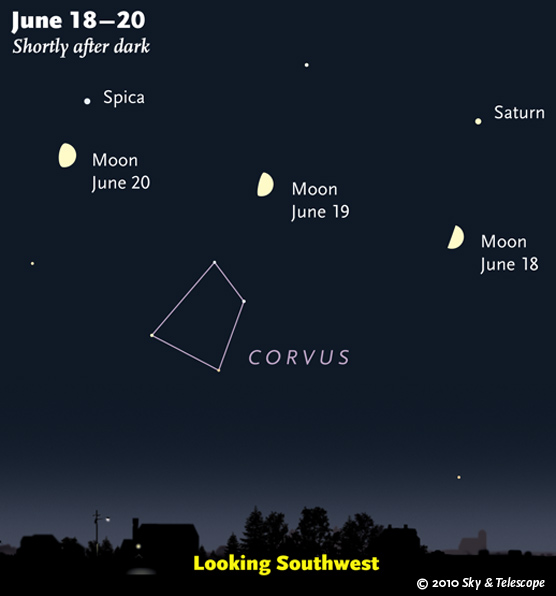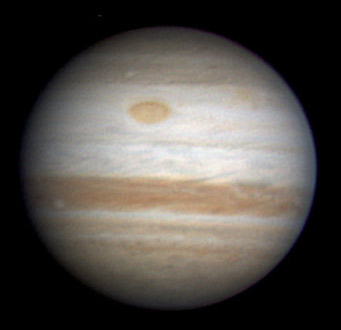Dawn Comet. Comet C/2009 R1 (McNaught) is brightening but dropping lower in the dawn as it crosses Perseus and Capella low in the northeast. Look early in the week. It's about 5th magnitude; binoculars are showing it nicely, but a telescope does better. See our article and finder chart.
Friday, June 18

Waxing past first quarter, the Moon marches eastward below Saturn and Spica.
Sky & Telescope diagram
Saturday, June 19
Sunday, June 20
Monday, June 21
Tuesday, June 22
Wednesday, June 23
Thursday, June 24
Friday, June 25
Saturday, June 26
Want to become a better amateur astronomer? Learn your way around the constellations. They're the key to locating everything fainter and deeper to hunt with binoculars or a telescope.

The Pocket Sky Atlas plots 30,796 stars to magnitude 7.6 — which may sound like a lot, but that's less than one star in an entire telescopic field of view, on average. By comparison, Sky Atlas 2000.0 plots 81,312 stars to magnitude 8.5, typically one or two stars per telescopic field. Both atlases include many hundreds of deep-sky targets — galaxies, star clusters, and nebulae — to hunt among the stars.
Sky & Telescope
For an easy-to-use constellation guide covering the whole evening sky, use the big monthly map in the center of each issue of Sky & Telescope, the essential magazine of astronomy. Or download our free Getting Started in Astronomy booklet (which only has bimonthly maps).
Once you get a telescope, to put it to good use you must have a detailed, large-scale sky atlas (set of charts). The standards are the Pocket Sky Atlas, which shows stars to magnitude 7.6; the larger Sky Atlas 2000.0 (stars to magnitude 8.5); and the even larger and deeper Uranometria 2000.0 (stars to magnitude 9.75). And read how to use your charts effectively.
You'll also want a good deep-sky guidebook, such as Sky Atlas 2000.0 Companion by Strong and Sinnott, or the more detailed and descriptive Night Sky Observer's Guide by Kepple and Sanner or the classic if dated Burnham's Celestial Handbook.
Can a computerized telescope take their place? I don't think so — not for beginners, anyway, and especially not on mounts that are less than top-quality mechanically. As Terence Dickinson and Alan Dyer say in their Backyard Astronomer's Guide, "A full appreciation of the universe cannot come without developing the skills to find things in the sky and understanding how the sky works. This knowledge comes only by spending time under the stars with star maps in hand."
This Week's Planet Roundup
Mercury is lost deep in the glow of sunrise.
Venus (magnitude –4.0, in Cancer) is the bright Evening Star shining in the west-northwest during and just after twilight. In a telescope, Venus is still a small (15-arcsecond) gibbous disk. It's so dazzling, in its brilliant illumination by the Sun, that you'll have the cleanest telescopic views of it in the bright blue sky before sunset — if you can find it then. Not until late summer will Venus assume its larger and more dramatic crescent phase.
Mars (magnitude +1.3, in Leo) shines in the west after dusk, with Regulus increasingly far to its lower right. Mars is fading; it now matches Regulus in brightness. The star to their upper right is Gamma Leonis, only a little dimmer. Farther to their lower right shines Venus. In a telescope Mars is just a very tiny blob, 5.5 arcseconds in diameter.

Jupiter's Great Red Spot is still floating free in the practically nonexistent South Equatorial Belt. Imager Christopher Go notes that the spot's south rim was especially dark. The slightly orange smudge to the upper right is Oval BA, "Red Spot Junior." South is up.
Go took this image at 20:37 UT May 30th, when the Great Red Spot had just crossed Jupiter's central meridian. the central meridian longitude (System II) was 157°.
Jupiter (magnitude –2.4, in Pisces) rises around 1 a.m. daylight saving time and shines high in the southeast before dawn. Nothing else there is nearly so bright. See our article on Jupiter's disappearing South Equatorial Belt.
Jupiter's Great Red Spot is near System II longitude 150°. Assuming it stays there, here's a list to print out of all the Great Red Spot's predicted transit times for the rest of 2010.
Saturn (magnitude +1.1, in the head of Virgo) glows in the west during evening, upper left of Mars. The diagonal line of Saturn, Mars, Regulus, and Venus is shrinking; the three planets will bunch up low in the sunset in early August.
In a telescope Saturn's rings are 2° from edge-on, their minimum tilt for the next 15 years. Note the thin black shadow-line that the rings cast on Saturn's globe.
Uranus (magnitude 5.9, in Pisces) is less than 2° from Jupiter. In a telescope Uranus is only 3.6 arcseconds wide, compared to Jupiter's 40″.
Neptune (magnitude 7.9, at the Aquarius-Capricornus border) is in view during early morning hours well to Jupiter's west. See our finder charts for Uranus and Neptune in 2010.
Pluto (magnitude 14, in northwestern Sagittarius) is high in the south-southeast by midnight. See our Pluto finder charts for 2010.
All descriptions that relate to your horizon or zenith — including the words up, down, right, and left — are written for the world's mid-northern latitudes. Descriptions that also depend on longitude (mainly Moon positions) are for North America. Eastern Daylight Time (EDT) equals Universal Time (also known as UT, UTC, or GMT) minus 4 hours.
To be sure to get the current Sky at a Glance, bookmark this URL:
http://SkyandTelescope.com/observing/ataglance?1=1
If pictures fail to load, refresh the page. If they still fail to load, change the 1 at the end of the URL to any other character and try again.
 0
0
Comments
You must be logged in to post a comment.